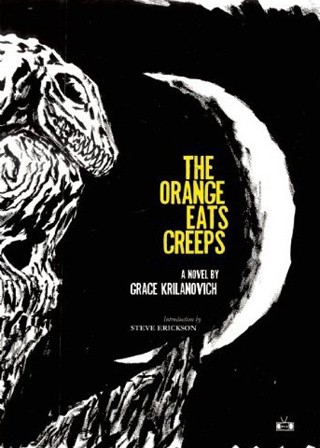Unofficial Official Hairpin 3.0 Book Club: The Orange Eats Creeps

“As a vampire, you’re undead, as a sexy girl you’re dying all the time.”
Do you ever wake up from a nightmare — or any intense dream, really — remembering fragments of what happened or certain feelings felt but not really…much else? The first time I finished The Orange Eats Creeps by Grace Krilanovich, which I did only a few days ago, I closed the book, put it down, and immediately thought, “Wait, what?” It was like 200 pages of the Black Lodge sequence from Twin Peaks. It was like being at a party where everybody else is on acid except for you, which somehow makes you feel like you’re tripping out harder than everybody there. It is that feeling you get when you try to fall asleep alone in your apartment after watching a horror movie that didn’t really scare you, exactly, but maybe you should sleep with the lights on just in case. It is drinking six cups of black coffee and then blasting one of Sonic Youth’s earliest, noisiest albums, which, incidentally, is what I did as I read this book.
And yet! That is not to say nothing from the book stuck with me. I underlined so many passages on every page, perfect lines that were prescient and dramatic and moody that captured the essence of teen girlhood:
But what doesn’t kill ya leaves its mark and you can read it like a book. I store the history of what happened to me here, in my body. This journey is going to help me tease it out.
The objects that occupy my mind in these moments when white madness fades and bloodsucking rage emerges from a crack in my fractured teen psyche: one, my pornographic obsessions, memory, anarchy, reflections on the inability of men around me to relinquish claims on my body.
There is something about being 17 and being immortal, like wishing you could turn into a magical being and then waking up, looking into the mirror, and seeing that you are.
So what is this book about? The unnamed narrator is a seventeen-year-old vampire roaming the Pacific Northwest with her gang of “Slutty Teenage Hobo Vampire Junkies,’ of which she is the only female. (“They are legally ‘men’ while I’m still a girl.”) The narrator is on the lookout for Kim, her sister from a foster home, who is maybe dead, maybe also a vampire, and maybe shares psychic visions with the narrator (who herself believes to be psychically connected to Patty Reed, a young member of the Donner Party).
About twenty pages into the book I realized that I would have to stop reading it as a novel with a linear story and instead approach it as the rambling diary of a crust-punk teenager who is maybe always high. (Luckily, I’ve had a lot of practice doing this. I had a Livejournal in high school.) There were times when I would get engrossed in what was happening only to realize I was reading an extended dream sequence (or hallucination?), and I constantly had to reread portions to determine if what I just read actually happened or not. The line between reality and fantasy is frequently blurred. Laura Van Den Berg at Tor.com writes, “Are Krilanovich’s drug-addled teenagers wandering the Pacific northwest in the nineties really vampires, or is their ‘vampireness’ more a metaphor for a profoundly deranged inner state?” I mean, why can’t it be both? I believe in the mythos of the story.
In his introduction, Steve Erickson writes “Twilight this isn’t.” There is a dichotomy between these two books about teenage vampires: one is a saccharine love story, the other is “gritty” and “raw.” (lol) One is the story of a normal teen girl (just like you!) who falls in live with a vampire, a living (or undead) metaphor of the mysterious bad boy, the heterosexual teen dream. I don’t hate Twilight. I see the appeal of its wish fulfillment, and think adults who make a habit of knocking it are boring. Yet the vampires of Twilight are presented as Humans, Only Better, shining so bright they literally sparkle. I was excited to read a book where the vampire protagonist was girl, “only” a girl, who has lived hard and experienced traumas and is routinely made to feel outside of her body, who barely identifies as human most days yet is still struggling to live as one.
Because none of the girls in this book — be they protagonists or unnamed extras — are actually girls. They are vampires, ghosts, shewolves, routinely referred to as creatures though never derogatorily. They are Girl Monsters, inhabiting “the space between mythology and female experience.” (There are boy monsters in the book too, and most of them even have names, but I tended to forget them seconds after reading them.)
I am currently reading The Orange Eats Creeps for the second time. Rereading is something I rarely do, especially so soon after finishing it the first time. I feel like there is so much I missed, and I want to absorb everything these Slutty Hobo Vampire Junkies have to offer.
To those of you that read it: what did you think? Did it drive you mad, or just crazy? Did you read the characters as vampire-vampires, metaphor-vampires, or something else entirely? Also: what would you like to read next month? Let me know in the comments, or e-mail [email protected]!